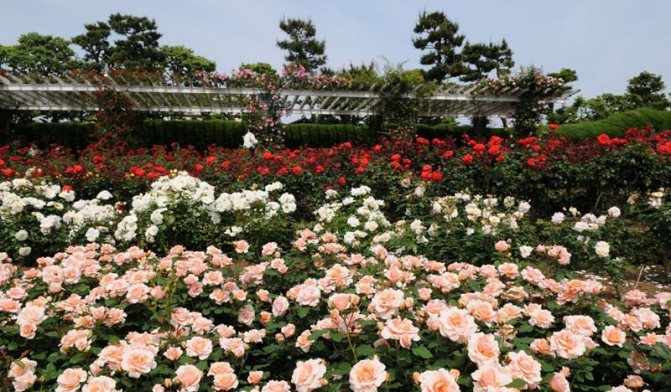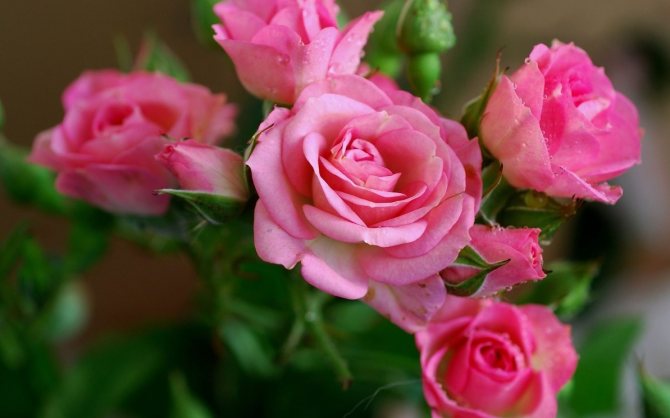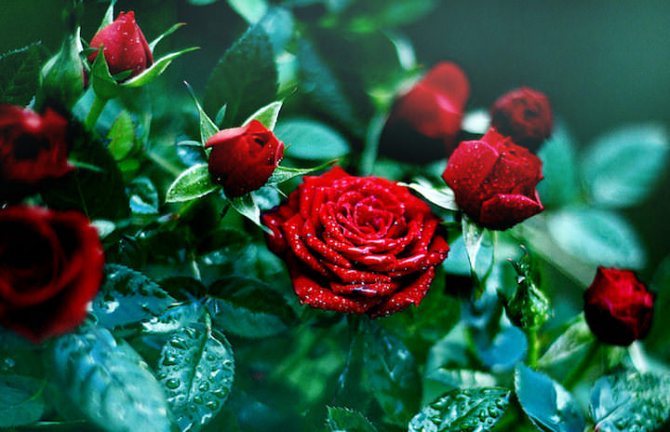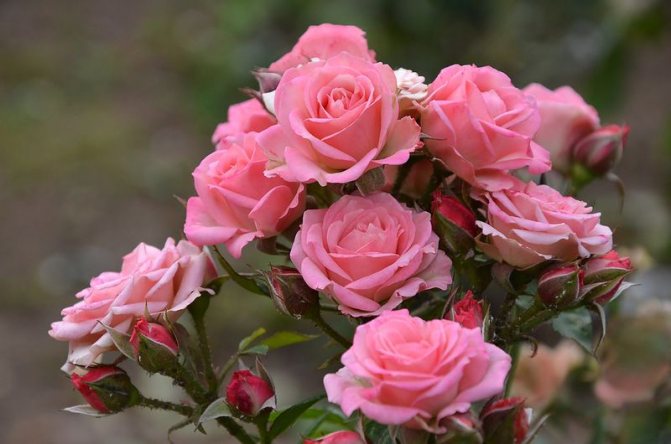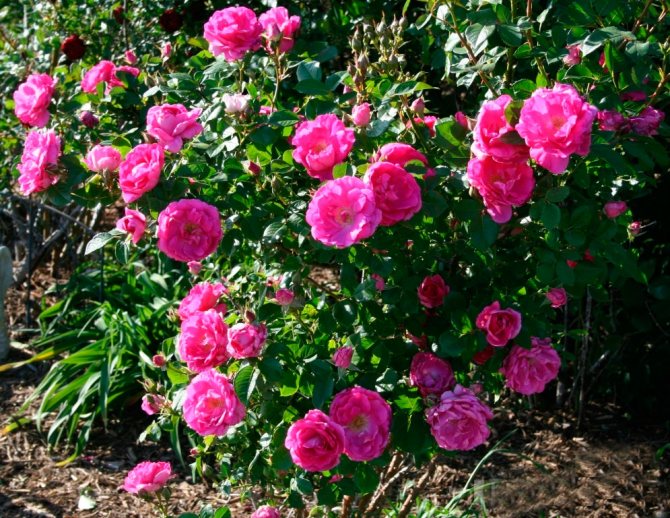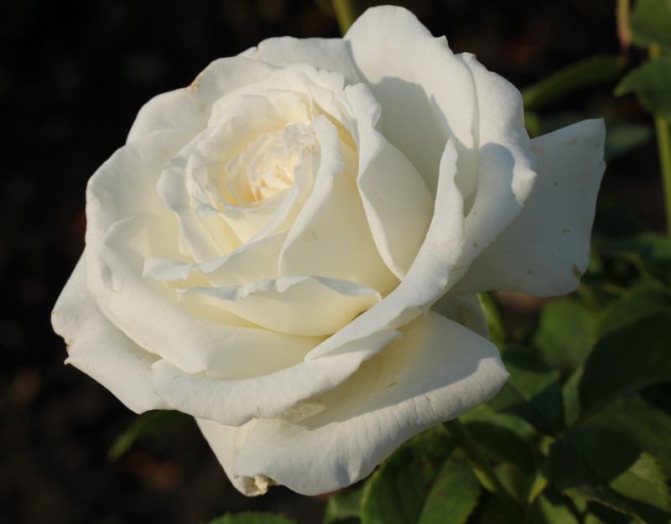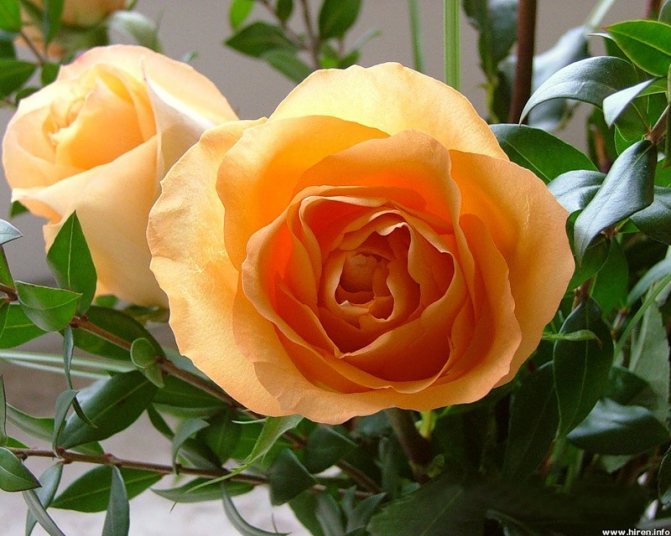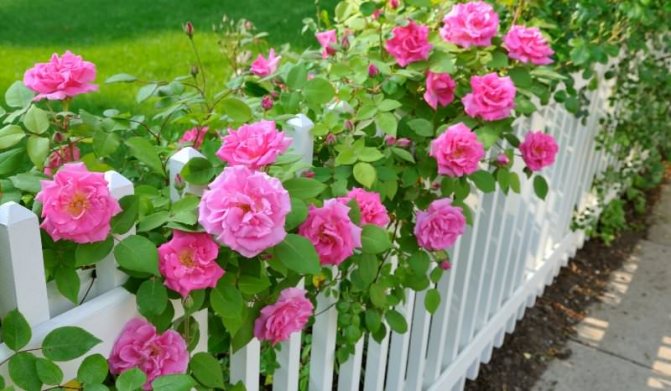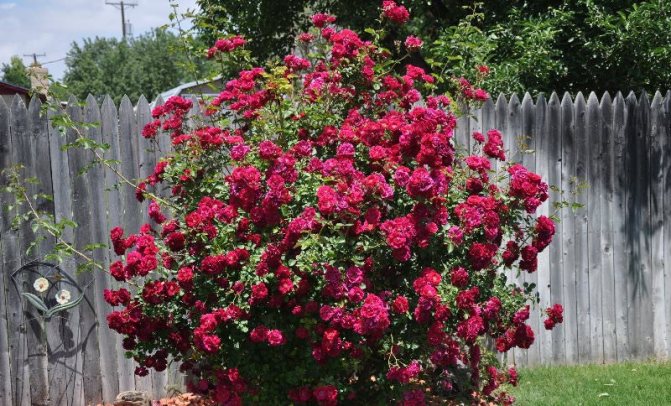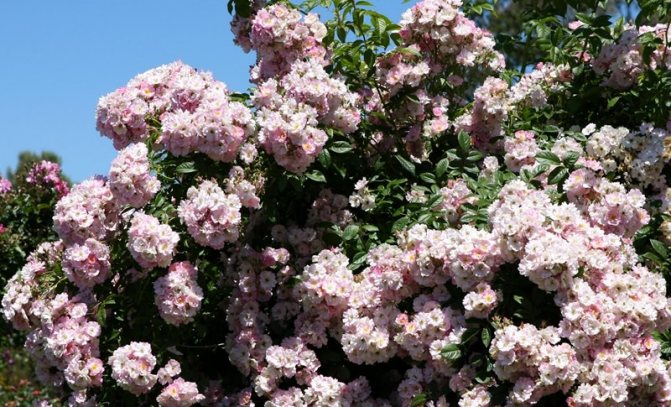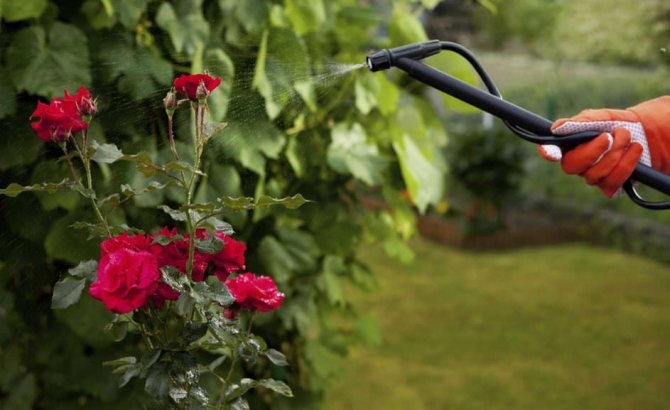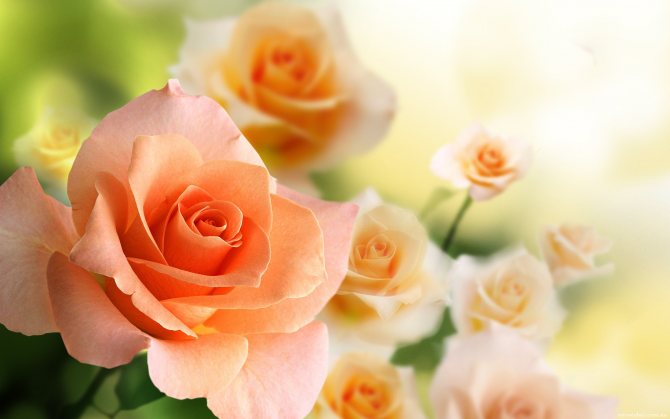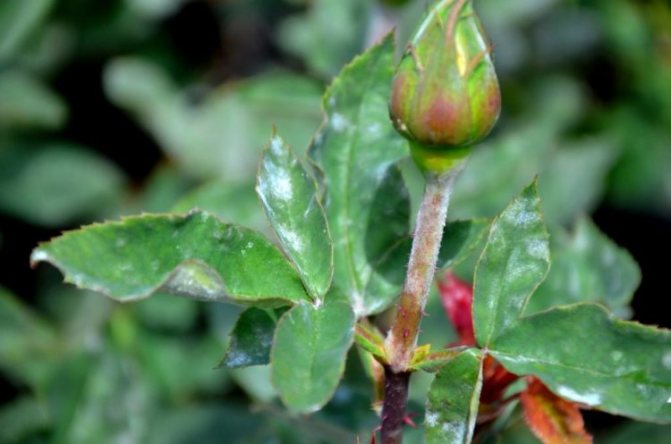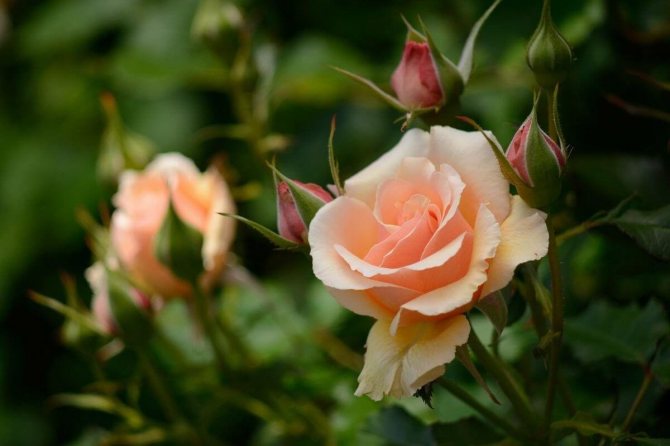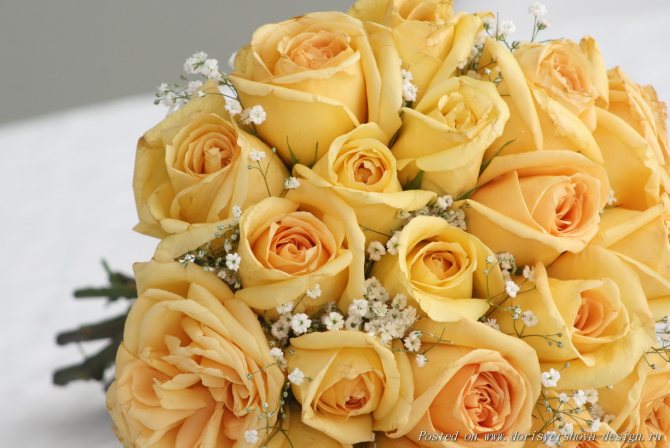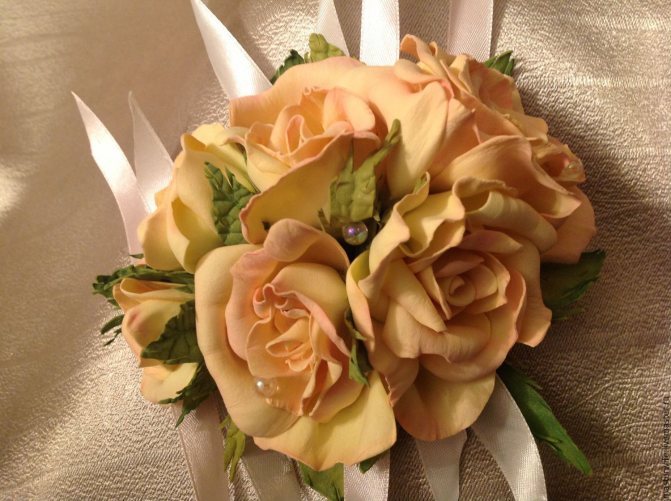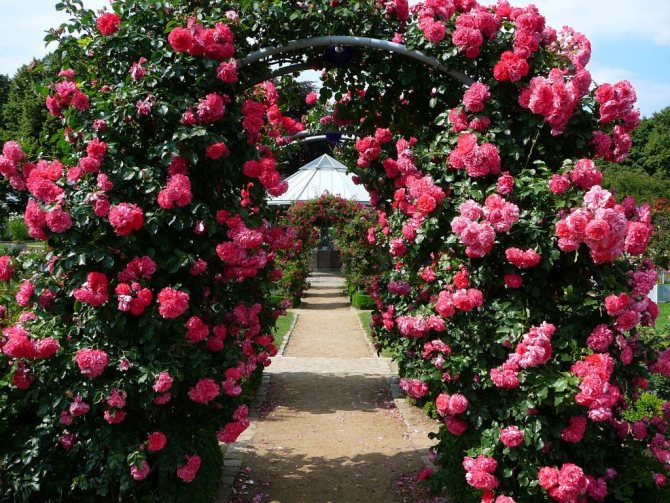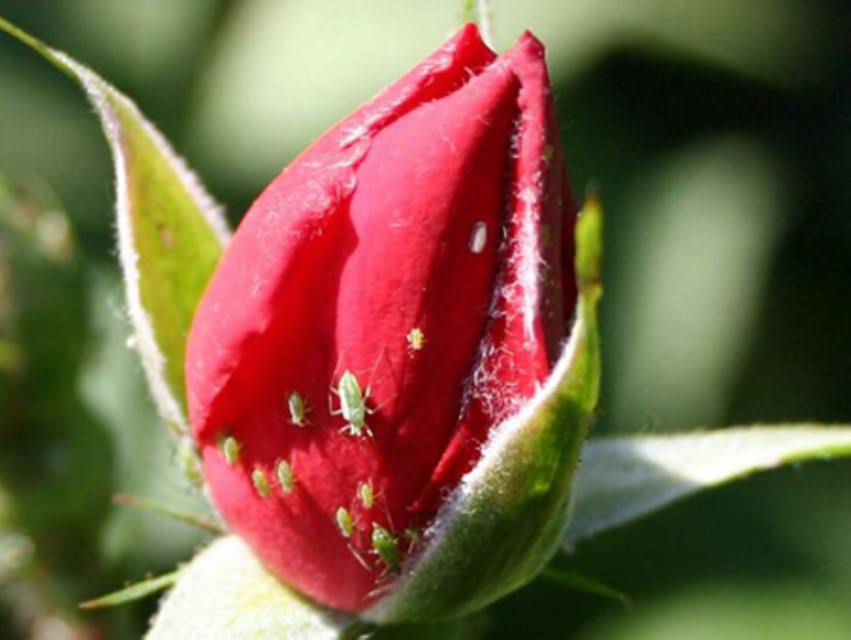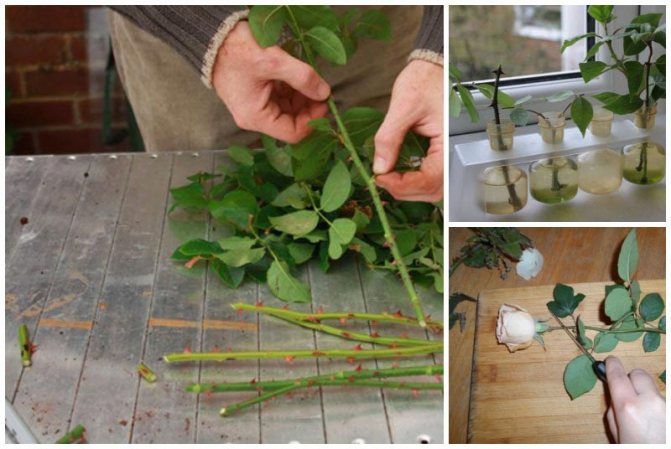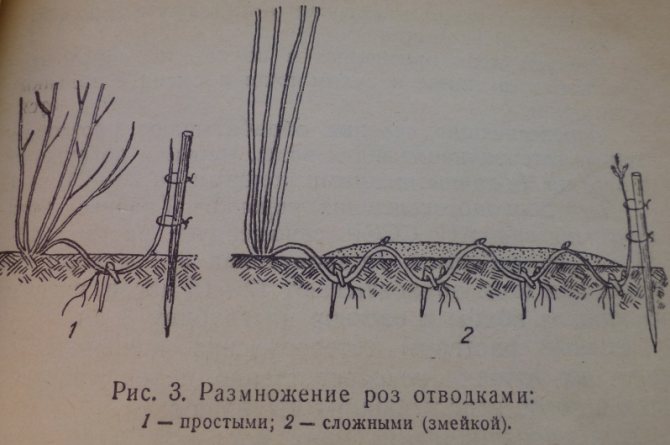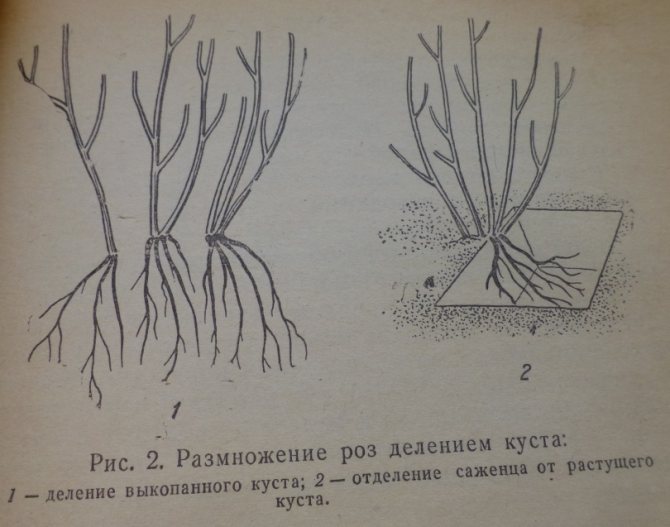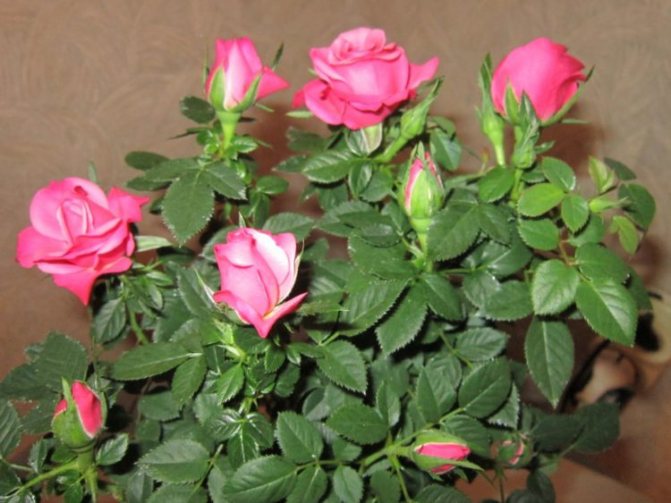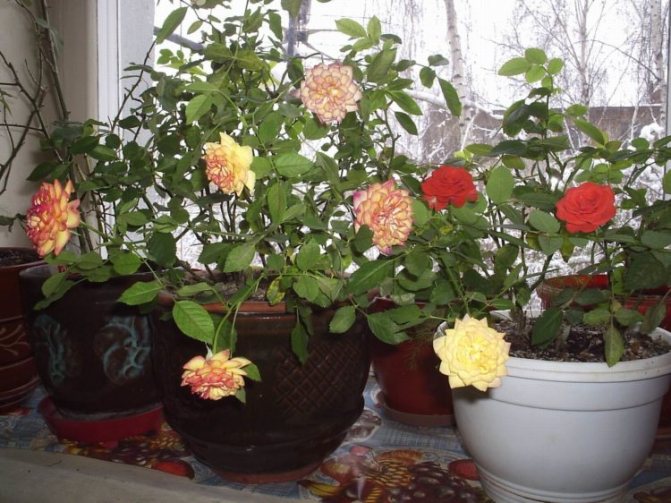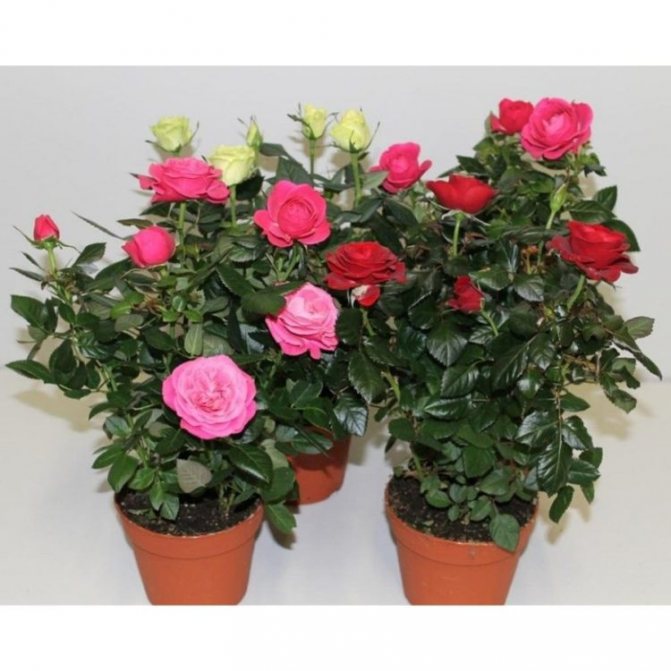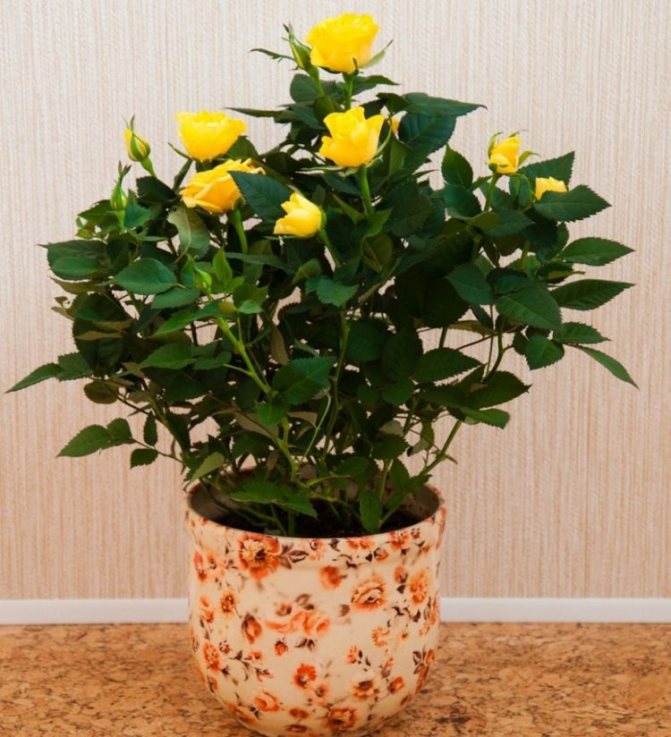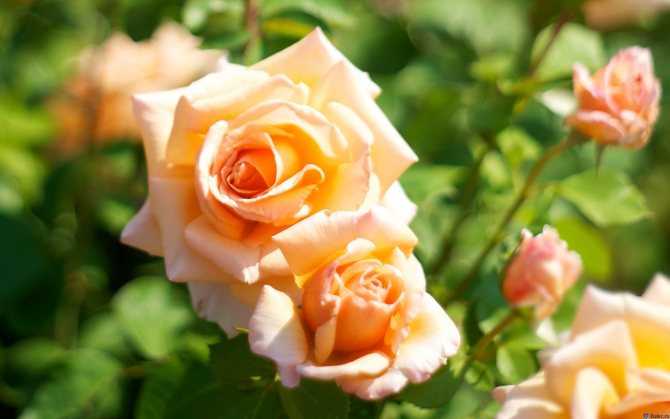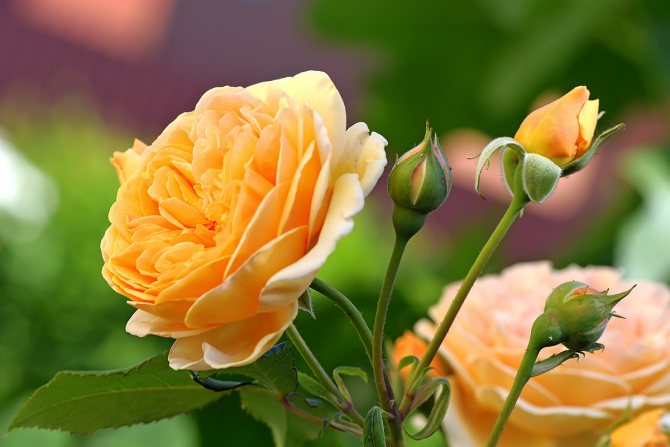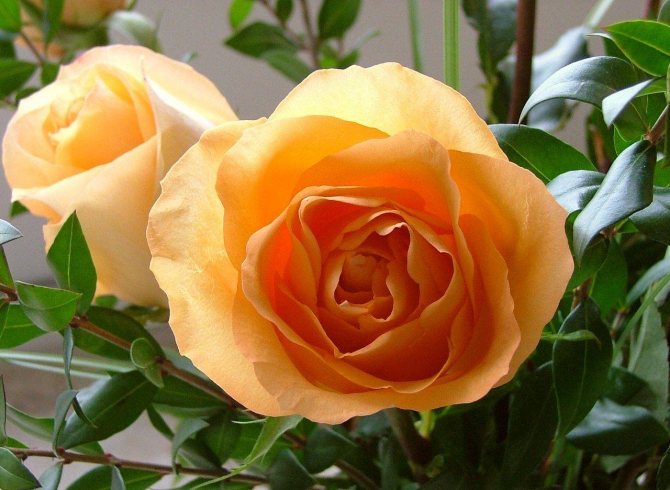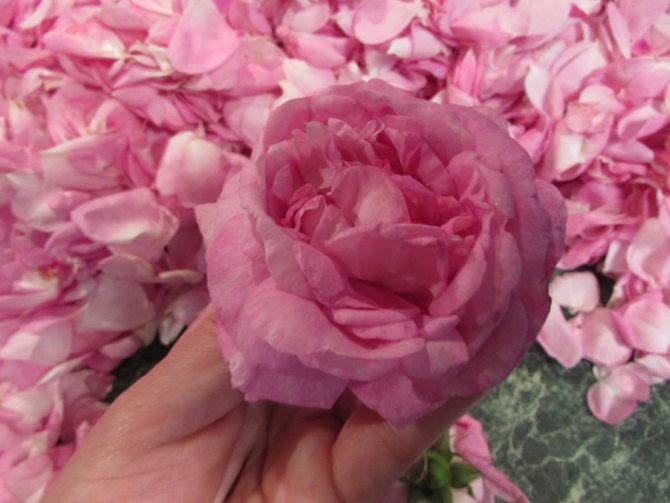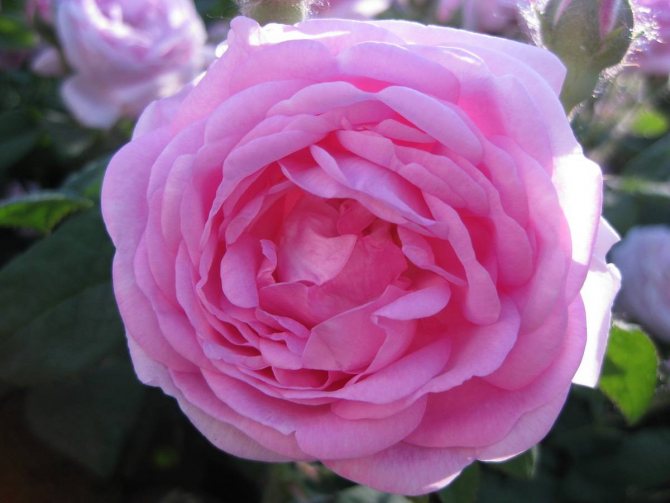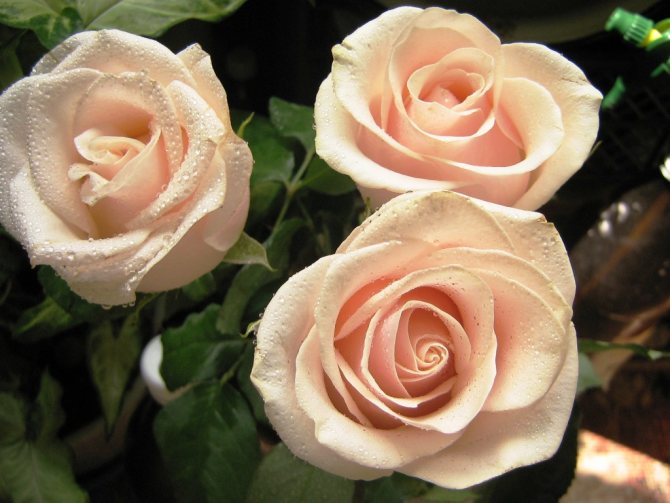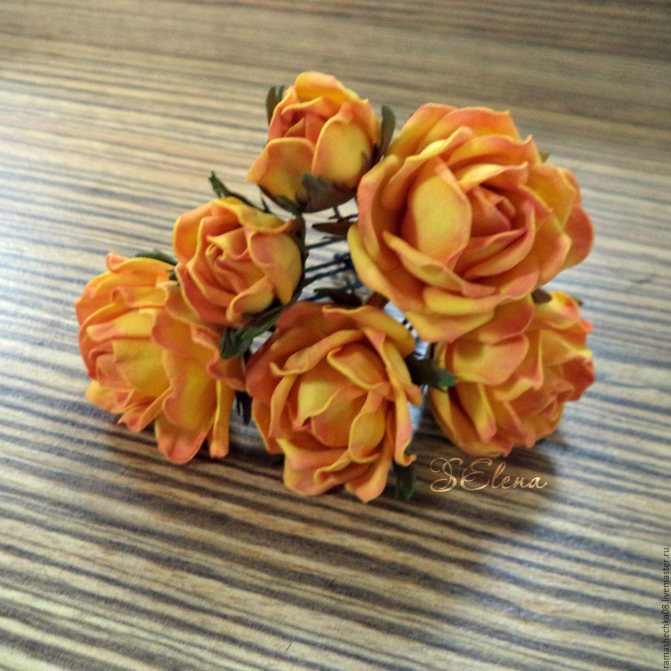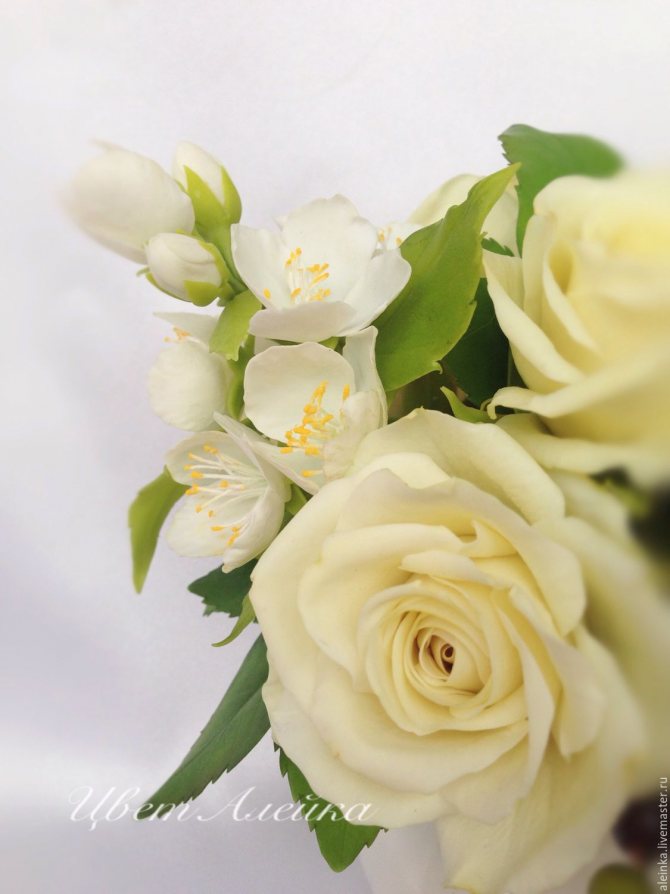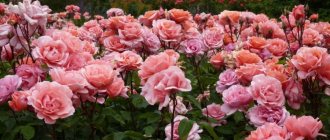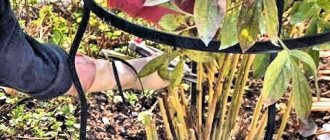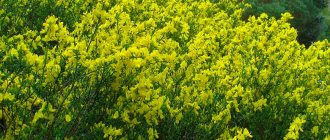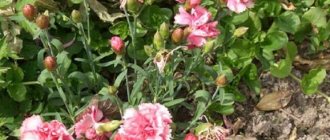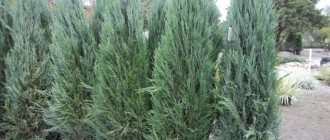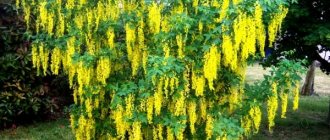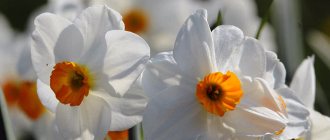Shrub roses belong to the genus of rose hips, which appeared on Earth about 40 million years ago. Today this genus unites about 250 species of various plants and more than 200 thousand varieties. At first, the rose was called by the ancient Persian word "wrodon", then in Greek it was called "rhodon". Later this word was transformed by the Romans into "rosa". In temperate and warm regions of the Northern Hemisphere, roses can be found in the wild, they are not inferior in beauty and excellent aroma to garden forms. Today, gardeners grow a variety of varieties and hybrids of this plant, which are distinguished by the amazing beauty of the flowers. They are especially popular not only among flower growers, gardeners and landscape designers, but also among all lovers of beauty. Despite the fact that roses have an incredibly beautiful appearance, they are very easy to grow. This explains their widespread use in green building. There are the following types of cultivated roses: garden and park. The most popular among garden roses are the following groups: hybrid tea, grandiflora, climbing, ground cover, bush, floribunda, polyanthus, and miniature. Below will be described in detail about spray roses.
general characteristics
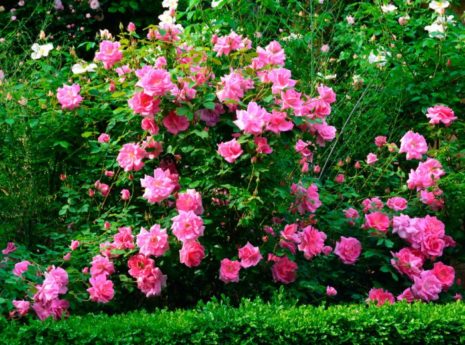
Today the group of spray roses has several thousand different varieties, varieties and hybrids. Various types of roses are represented by tall shrubs or dwarf plants, they can be spreading or upright, with strong or flexible shoots, as well as flowers of all kinds of colors and sizes.
Most varieties of spray roses are remontant, that is, they bloom many times during the growing season. However, there are also representatives who give out the beauty of color once a summer. All spray roses are distinguished by long-term profuse flowering. Their flowers usually exude a faint, pleasant pink scent.
By the way!
All old varieties of roses are classified as spray roses.
Features of a bush home rose:
- bush height from 30 to three meters;
- bush shape - compact or spreading;
- shoots are smooth and studded. There are one and two years. Solid and flexible;
- leaves are elliptical, dense, wrinkled, matte, green;
- flowers from 8 to 18 centimeters in diameter. Grow singly or in inflorescences;
- little or no aroma;
- the number of petals is from 35 to 150 pieces;
- the shape of the buds are cupped, spherical, goblet-shaped, peony-shaped.
Among other things, the vast majority of spray roses are distinguished by high winter hardiness, good immunity to diseases and relative unpretentiousness to care.
Site selection and soil preparation
A comfortable place for a bush rose will be a site, without drafts and wind, illuminated throughout the day. It is good if in the midday sun they are protected by a light shade.
Planting roses is best done in neutral, fertile, well-drained soil. You can improve acidic soil by adding lime to it, Loamy - sand and manure, sandy loam - mineral fertilizers.
Planted roses take root well at 12-17 C of the soil.
French roses
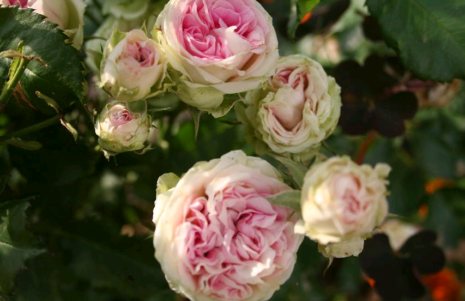

All varieties of French roses are an ancient floral genus, created on the basis of the wild-growing shrub Rosa galica.
The features include the short stature and compactness of the bush. They do not bloom for long (from mid-June to mid-July), but very abundantly, while fragrant with pleasant wondrous aromas.
What distinguishes French roses from all other representatives of this culture is the uncharacteristic color of the flowers. Almost all of them are dark pink or blood red in color. The petals are usually double or semi-double. The buds in the opened form are small in size, their diameter rarely exceeds 6 centimeters. Roses of this group are quite winter-hardy, but cultivation in the northern regions is not preferable. Under poor growing conditions, plants often deteriorate due to fungal diseases.
French roses have become the founders of hundreds of modern interspecific varieties and hybrids. The most interesting variety obtained from the Galika rose is the French large-flowered rose hybrid, which is characterized by double, brilliant red flowers.
Fact!
French roses exude a surprisingly delicate scent. It is believed that their smell is one of the strongest antidepressants.
Rosa gallica
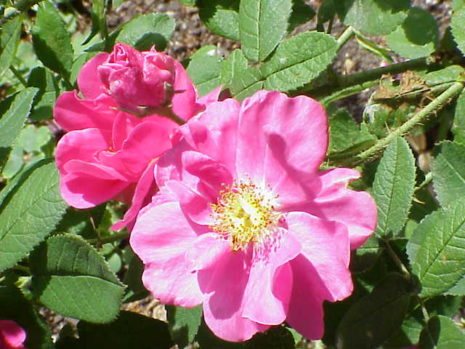

This is a variety of wild rose hips. It is a perennial branched shrub that grows up to one meter, has erect, solid shoots. The stems are covered with thorns of various shapes and sizes. The flowers of the French rosehip are large, formed singly on the shoots. The petals are simple, but they can also be double. Galika blooms in June-July. At the beginning of the color, the buds have a pale pink color, gradually turning into bright red. The aroma of flowers is weak, pleasant.
Cardinal de Richelieu
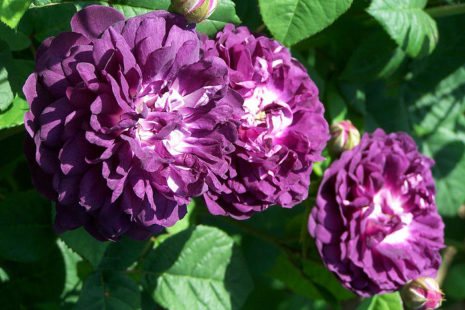

One of the most successful breeds, which is in very high demand all over the world. The rose is named after the French cardinal Richelieu. The variety has been known since 1747. Small flowers are distinguished by dark purple double petals and a bleached core. Interestingly, during opening, the buds have a pale pink tint. As it blooms, the color changes to lilac and gradually turns purple. Flowering occurs in early July and lasts not much more than a month.
Cardinal Richelieu is a low, semi-spreading bush that reaches a meter in height, growing with pleasure in the shade along the fences. He is quite undemanding in fertilizing and the fertility of the land, rarely gets sick and tolerates Russian winters tolerably.
conclusions
Roses are considered one of the most beautiful and fragrant flowers. In order to grow such flower waterfalls, it is necessary to follow certain recommendations, to properly care for the plants. This concerns the choice of a place, feeding, and other important processes.
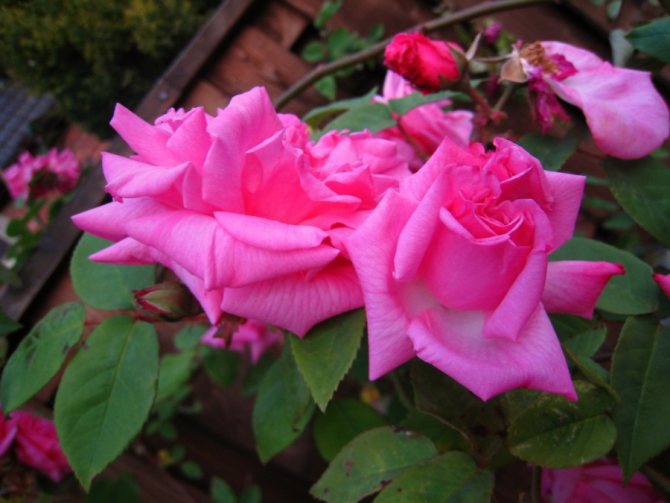

When grown properly, your flower bed will be rich in these noble shrubs.
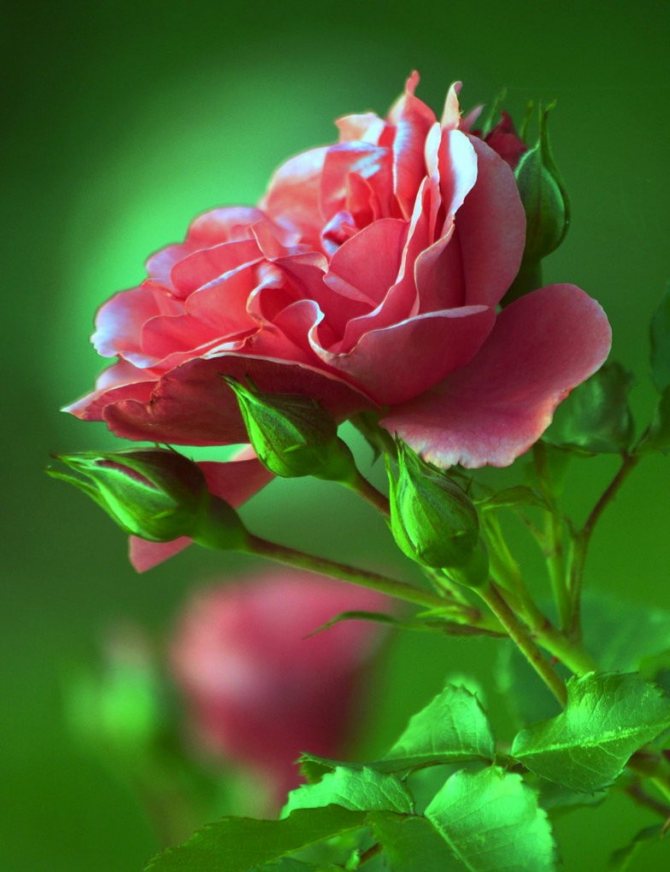

English roses
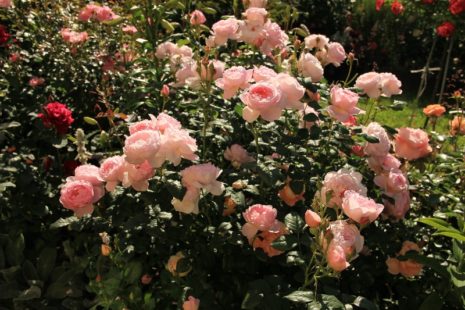

Amateur breeder David Austin gave the world more than 200 varieties of spray roses (this includes individual varieties and variety series), which are united in a group called "English roses". With his work, he breathed life into the undeservedly forgotten forms of shrub flowers (Damascus, Bourbon, Gallic, Albu), and through experiments he achieved from new varieties an enhanced enchanting aroma of petals and the refined beauty of densely double buds, which mainly have rosette, pompom-shaped or cup-shaped glasses. English roses were developed by mixing bourbon roses, hybrid teas and floribundas. Austin's roses have absorbed all the best from their progenitors: they bloom for a long time and profusely, they are able to take root on any land and in any climate, are unpretentious in care and cold-bloodedly endure the absence of direct sunlight. In addition, all types of roses are of the remontant type, that is, they bloom twice per season. English roses are different types of climbing and climbing plants that can be grown as a regular bush, giving it a different shape each year.Rose flowers can have all sorts of colors and shapes, there are densely double and buds with regular petals. And they all have strong immunity to disease. Due to these features, Austin roses are popular with landscape designers and private owners.
Abraham Derby
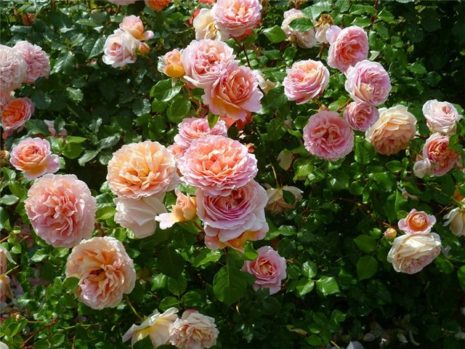

One of the most successful breeder varieties. Abraham Derby is a dense, compact growing bush, abundantly covered with flowers of the classic shape of an old cup-shaped rose. The buds have an apricot color with a pronounced copper, golden tint. Gradually, the color changes to pale pink with a yellowish shine. The flowers are very large, the diameter of the buds sometimes reaches 15 centimeters. They appear at the ends of the shoots more often one at a time, but it happens that they are connected to sockets of 3-5 pieces. Roses exude a strong fruity aroma with a subtle hint of strawberry. Flowering occurs in waves, repeated 2-3 times a season. From a heavy load of heavy flowers, flexible thin shoots often lean to the ground. To avoid breaking the whip, they are usually tied to supports - this way you can demonstrate the beauty of the flowering of the bush.
By the way!
Abraham Derby is a powerful strong rose with healthy immunity and an enviable vigor of shoot growth, therefore, most often the rose is grown as a climbing one.
Benjamin Britten
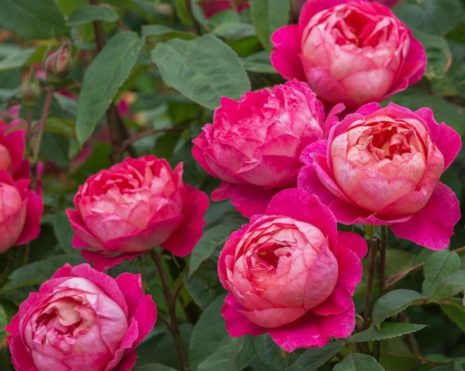

This variety stands out among other English species with an unusual color for their palette - the flowers are bright red, bloody color with an orange tint. Cup-shaped flowers after blooming take the form of a rosette. Buds appear unevenly throughout the summer. Benjamin Britten's bush is tall, often reaching two meters, although its average growth by standards is about one meter. The plant is highly branched, spreading, densely leafy. Without additional pruning, long flexible shoots quickly intertwine with each other, forming thickets that are difficult to cut. The flowers give off an intense pear scent with a wine tinge. The distinctive features of the variety include its adherence to fungal diseases and absolute unpretentiousness in care. The only drawback of this species is not too lush and long flowering, unlike other Austin varieties.
Propagate by cuttings, layering, dividing the bush
How to plant bush roses:
| Cuttings Stages:
|
| Layers Stages:
|
| Dividing the bush Stages:
|
Floribunda roses
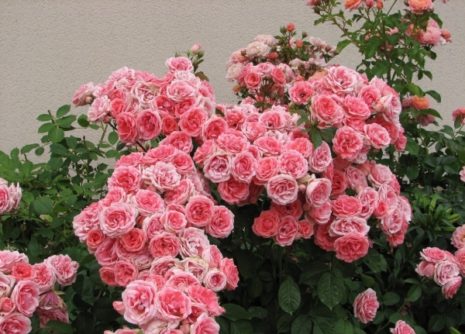

A common group of roses, often used by decorators to decorate the garden.In their biological characteristics, they are similar to hybrid tea and hybrid polyanthus roses, from which they actually originated. Rose plants appear as spreading shrubs up to 70 centimeters high. Plants bloom for a long time, tolerate winters well, rarely get sick, do not require special care. The flowers in this group are large (8-12 centimeters in diameter), the shape and color palette are the same as in hybrid tea varieties. Collected goblet buds are usually 15-18 pieces in bulky umbellate inflorescences, as in hybrid-polyanthus. The petals are of varying degrees of doubleness. Some varieties have a subtle aroma inherent in roses. Floribunda roses bloom in the middle of summer and continue to delight the eye until the end of September, their flowering is continuous. They have a universal purpose. They are suitable for cutting, they can be grown in a greenhouse and decorated with flower beds in the open field. Flowers can take the form of a standard tree, and beautifully braid an arch or any other hedge.
Lili Marlene
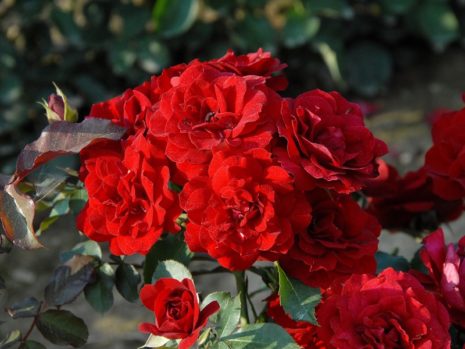

The most famous variety of the floribunda group. The rose blooms with lush red flowers with a copper tint throughout the summer until the very frost. Lily Marlene bushes are sprawling, medium-sized plants, reaching a maximum height of 70 centimeters. They have a dense, juicy green crown. The buds appearing on the shoots initially have an ordinary black color, which gradually turns into blood red. The shoots are strong and powerful, they can easily withstand the burden of hundreds of gradually blooming medium-sized (up to 8 centimeters in diameter) weakly double buds. One cluster usually contains up to 10-15 flowers. They have a loose structure, and therefore often deteriorate in the wind or during rain. Lily Marlene is a fairly disease-resistant variety, but with poor care it is often affected by powdery mildew. This variety can be grown both in the open field, using for landscaping unsightly places in the garden, or grown in tubs that are installed on verandas or indoors.
By the way!
More recently, Lily Marlene roses have been bred, which have pink petals.
Niccolo Paganini
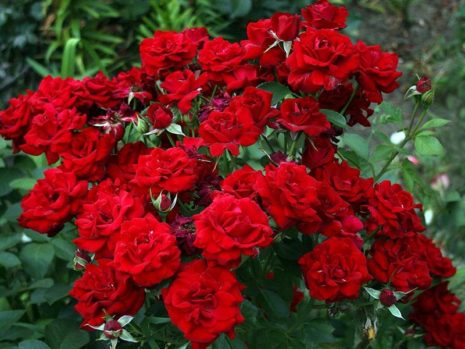

It is quite a traditional variety, characterized by medium-sized velvety-red flowers and a strong sweet aroma. The buds are composed of countless short petals that create a flawless cupped shape. On the brushes, the flowers are arranged in clusters, forming loose rosettes of 12-14 buds. The flowers bloom quickly and hold, keeping a beautiful look for a long time. The bushes of Niccola Paganini reach heights of up to 80 centimeters. They are quite resistant to frost, have an average vigor, are compact, and are rarely affected by diseases and pests. They grow well only on fertile soil, so they often need additional feeding. Of all the floribunda varieties, Niccolo Paganini boasts extremely long flowering and a unique ability to withstand prolonged heat. Therefore, this variety is quite widespread in the southern regions.
Roses of Niccolo Paganini are ideal for flower bed placement, for decorating massifs and mixed groups.
Preparing seedlings for planting
It is important to properly prepare the acquired planting material for planting. First of all: by slightly cutting it in the root system, broken and damaged parts are removed, dried and weak shoots or fruits are removed from the upper part of the plant, leaving up to 5 buds on strong shoots on those that are weaker up to 3. Sections must be lubricated with garden pitch ... To soften, the roots are kept in water for up to 10 hours, then enveloped in a mash made of clay and mullein (2: 1), diluted with water until sour cream.
Hybrid tea roses
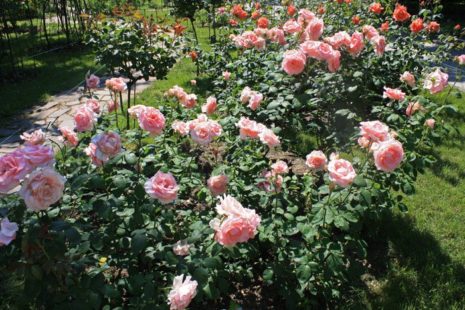

Roses of this group originated from the crossing of remontant varieties with tea and Indian roses (in particular, the LaFrance variety participated).The French breeder Guillot became the parent of this variety of roses. Hybrid tea roses are a short, compact bush (40-80 centimeters), erect or spreading type, which is overgrown with lush foliage and many large flowers. The diameter of the buds usually reaches 10 centimeters. On the shoots, they can form locally or gather in medium-sized inflorescences of 5-7 pieces. Plants are classified as remontant. After the first flowering, there is a two-week pause, which is replaced by a new rapid formation of countless dense buds, which fade by the end of October. Hybrid tea varieties are less winter-hardy than remontant ones. Today there are more than 10 thousand different varieties, each of which has an individual color and structure of flowers, intensity of aroma and bush shape.
By the way!
Hybrid tea roses have an unusual aroma of cut tea.
Flamingo
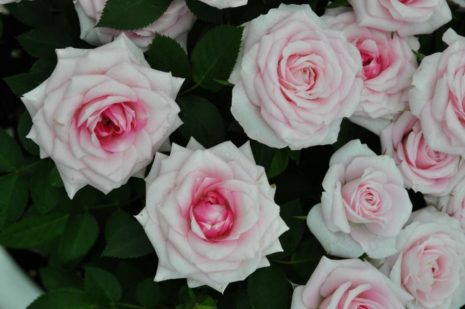

Varietal flowers have a pale pink shade of petals, which eventually fade in the sun to silvery pink. Flamingo roses are widely used as garden roses for decorating front gardens and flower beds. The buds are large (up to 11 centimeters in diameter), long, goblet, with a prominent center. Petals are weakly double. Flowers on shoots are formed more often singly, but sometimes they are collected in sockets of 5-7 pieces. Shoots are long, with frequent thorns, flexible, but rather strong so as not to bend under the weight of heavy flowers. The upright flamingo bush reaches 1.5 meters in height, quickly grows new branches, which have to be pruned regularly. In general, the variety is characterized as resistant to disease, but foliage can be affected by powdery mildew and other infections. The buds rarely get sick. Flamingo blooms long and profusely, enveloping the surrounding area with a delicate floral scent.
BigPurple
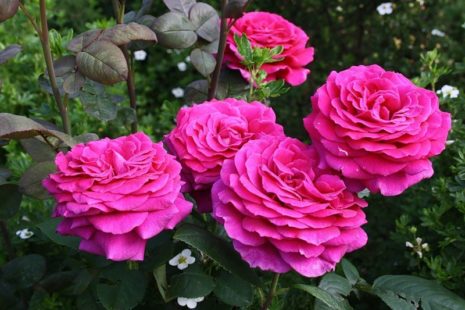

The variety was bred by an amateur breeder from New Zealand. The Big Purple rose differs from other hybrid tea roses in its color - the petals have a rich burgundy color, which changes depending on the weather: on warm days, the petals have a juicy raspberry hue, and with the onset of the cold pore they turn purple or burgundy.
Fact!
The main advantage of the Big Purple rose is a strong, persistent, delightful aroma that interrupts the smells of other close-planted flowers.
When incipient, the buds have an oval shape and a very dense structure, but as they open, they become terry cupped. In blooming, the petals are far enough from each other, so the appearance of the roses cannot be preserved during the rains. Flowers form on the shoots slowly and in waves, thus flowering takes place for a very long time, approximately until the beginning of October. The diameter of the opened buds sometimes reaches 15 centimeters. Varietal bushes are quite tall, often their height exceeds 120 centimeters. Compact in structure, shoots grow mainly upward, keep their shape well during intense flowering. Big Purple is a disease and cold resistant variety, rather unpretentious to growing conditions.
Shrubs
This word conventionally denotes a new generation of spray roses. Translated from English, the word shrub just means "bush", which made a little confusion in the classification. Their bushes are more compact and smaller than those of ordinary parks. Shrubs can be half-leafy, or in the form of a bush, if pinched in time. Roses tolerate frost well, with flowers of the most varied colors, up to striped ones. Most are almost odorless. There are a great many varieties of them, but there is one with extraordinary inflorescences that deserves a separate study.
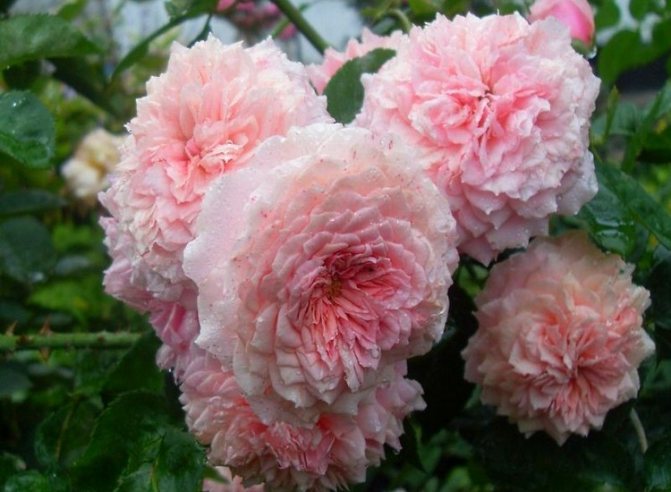

William Christie - perennial spray roses
William Christie. Bred by French breeders in 1994, named after the famous conductor.It has a strong fruity aroma and amazing flowers that cause constant delight with its unique complex shade, which is difficult to describe. Its symmetrical narrow petals are neatly collected in dahlia-like inflorescences with a lilac-pink color.
Climbing roses
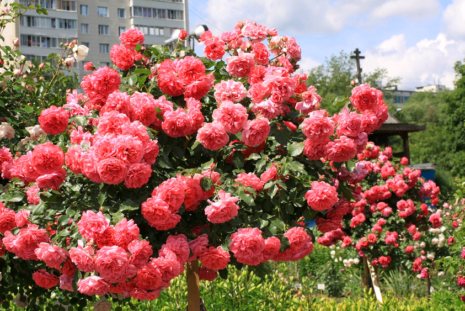

You may be interested in: Favorable days for cutting roses in the fall under a bottle Caring for a room rose in a pot at home Cutting roses in autumn at home
Climbing or curly roses originated from the multi-flowered Vihura rose, which was repeatedly crossed with various types of tea, hybrid tea and other varieties of roses. The result is vigorous plants (the height can reach four meters), which are today used for vertical gardening. There are three groups of climbing roses:
- curly (height up to 15 meters);
- climbing (height up to 5 meters);
- semi-plaited (height up to 3 meters).
Their shoots can spread along the ground or rise up, which makes it possible to attach them to almost any support. Flowers can be of a wide variety of sizes, shapes and colors. They are often collected in large, loose paniculate inflorescences. Most varieties are odorless, some of them smell very faint. Climbing roses bloom once a year for a long time. The buds bloom alternately, one after the other, after the previous inflorescences wither. Moreover, on branches of different ages, flowers form at different times.
Fact!
Only in the semi-growing variety New Down, the flowers bloom all at the same time and bloom until the very frost.
Excelsa
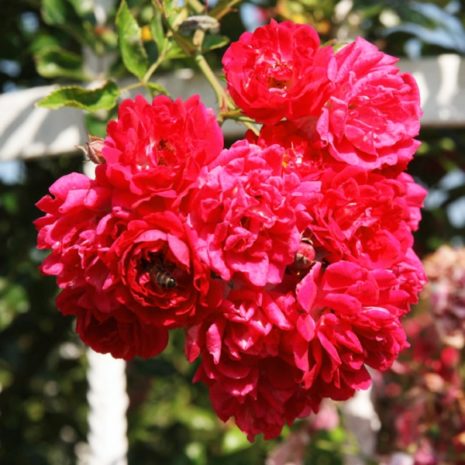

An old variety (bred in 1908), it is considered a classic in the rose-growing trend. Rosa Excelsa is a long flexible vine that grows several meters per year. The maximum plant height reaches 5-6 meters. Thin green shoots are densely covered with dark green glossy foliage, which during the flowering period is lost among the myriad of small, wide-opening, densely double flowers (1-2 centimeters in diameter), collected in bulky cyst-like inflorescences. Each of them consists of 50-60 crimson-red buds. Flowering occurs in mid-summer and lasts a month and a half. All this time, the sweet aroma of vanilla is in the air. Roses are incredibly hardy. They can easily survive cold winters and can thrive in the shade. However, they do not respond well to multi-day drought. Any soil, even depleted soil, is suitable for cultivation. Often, the bushes are affected by powdery mildew.
Super Excels
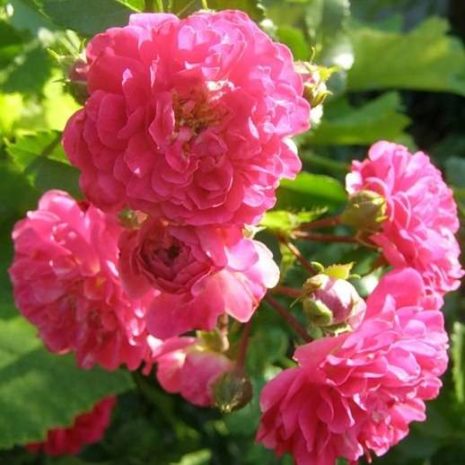

This rose was bred relatively recently, it is an improved version of the ordinary Excelsia. Its advantages over its predecessor of the same name are that Super Excelsa is endowed with a higher resistance to diseases and pests. Its main feature is re-flowering. Changes in the updated Excelsia also affected the shape of the bush - now it is not so tall and spreading, its height barely reaches two meters. Flowers 3-4 centimeters in diameter are collected in huge panicle inflorescences. For the first time, Super Excelsa blooms very profusely, she does not repeat this with a second color. The buds, when opened, have a white core and a crimson base color of the petals.
How to trim properly


What time to prune
Pruning roses is the most time-consuming procedure in caring for such plants, which must be done. After pruning, the bush will become more branched and the number of flowers will increase. Cut the stems in the spring, summer and autumn. Pruning carried out in the spring is the most significant, as the bush will be able to get rid of unnecessary and damaged stems, as well as its formation. In summer, as a rule, pruning is carried out only for sanitary purposes. So, during it, all the extra buds are removed, leaving only one, as a result of which the flower turns out to be very large and beautiful.Withered flowers and existing fruits are also removed. In autumn, pruning is needed in order to remove all weak, injured and diseased stems, which take a lot of strength from the rose.
How is pruning done
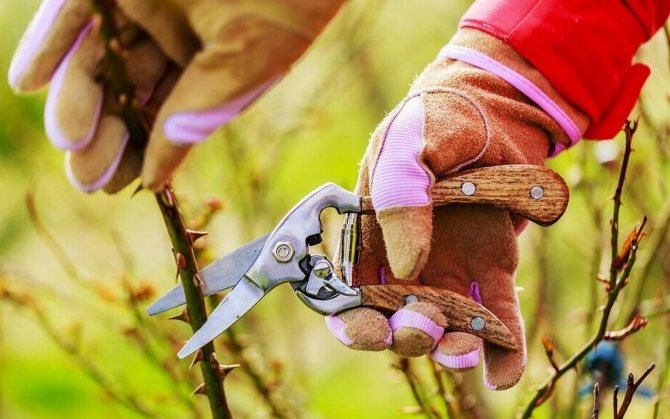

All injured and weak branches should be removed from the bush before the buds swell. You also need to cut off those branches that grow inside the bush, and then you can proceed directly to the formation. In the event that 2 branches interfere with each other, you need to cut off the one that is less well placed, or leave the one that is younger (the bark has a light color). When growing a grafted bush rose, you need to pay special attention to pruning the root shoots, because it takes a lot of energy from the flower, as a result of which flowering may not occur at all. It is recommended to cut off all but the strongest and toughest stems, which should bloom this year. If you are unable to properly cut off a faded bush, you need to do it at your own discretion. It should be remembered that after pruning, at least 2 buds should remain on the stems. Young greens appear rather quickly on the cut bush. Caution in pruning must be exercised when the soil is already depleted or the bush is old, because it is no longer able to so actively restore its own shape. In autumn, you should cut off all the flowers that have already wilted and you need to cut off damaged, weak branches or those that grow inside the bush. Be sure to process the cut sites with garden pitch.
The best varieties of spray roses by color
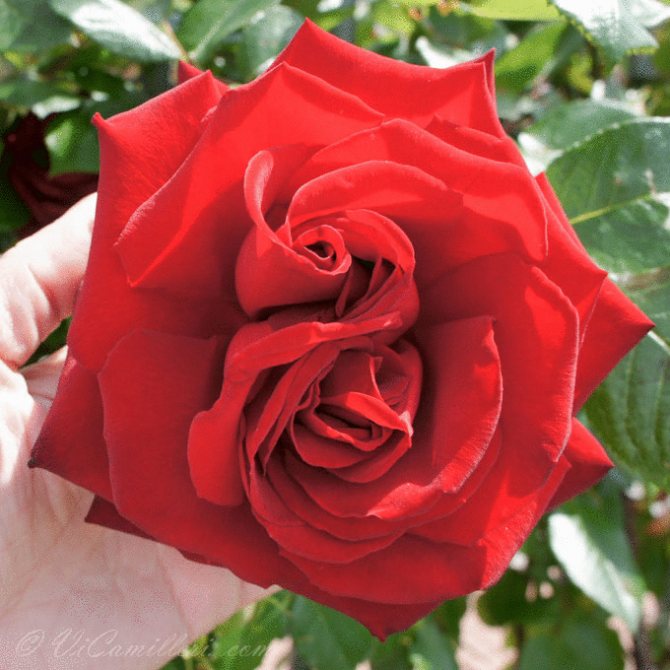

The color palette of roses is very diverse, today only flowers with blue and blue color do not exist. There are also few varieties of pure white roses, usually greenish, creamy or yellowish.
Yellow roses are represented by sand, lemon, canary and peach flowers with golden and copper tints. Orange - salmon, brick, dirty yellow. Reds are coral, scarlet, crimson and burgundy. Pink includes all shades of this color. A special group is made up of varieties with burgundy and purple flowers.
Petals can be painted not only in one color, but also shimmer in two or three shades, combine two contrasting colors or be variegated, multispectral. Many flowers have a light core and darker edges. In some varieties of roses, the underside of the leaves is painted in more delicate shades.
Yellow
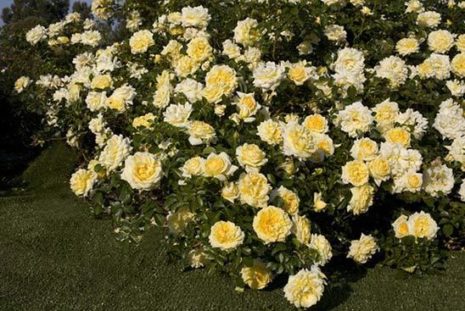

Natives of Central and Asia Minor, varieties of roses with yellow petals are quite demanding on weather conditions, soil fertility. They do not tolerate excessive moisture and often freeze in winter. Thanks to the efforts of breeders, there are already more than a hundred yellow-leaved varieties of this crop, which are willingly grown both in garden plots and for cutting. Bushes of yellow roses reach 1.5-2 meters, the shoots are long, densely covered with thorns. These roses bloom in June. The buds are large, located on the branches singly.
The best varieties:
| Variety name | Characteristic |
| Graham Thomas | The flowers are pure yellow. The rose blooms from June to August. Climbing bush, height up to 1.5 meters. It grows strongly, requires a lot of space. Poorly tolerates cold, therefore shelter is required. Demanding to regular fertilizing and soil fertility. Resistant to fungal diseases. Suitable for decorating arches, gazebos, hedges. |
| "Mary Rose" | Rose, part of the group of varieties of the Englishman David Austin. The petals are yellow-orange in color. The aroma is fruity. The buds are densely packed, and therefore do not deteriorate in bad weather conditions. The bush is powerful, reaching a height of 120-150 centimeters. It is preferable to grow in the southern regions, as the rose is afraid of frost. Most fungal diseases are alien to the plant, however, it is often affected by black spot. |
| "Kerio" | The variety belongs to hybrid tea varieties.The bright yellow flowers have a subtle floral scent. Plants have weak immunity, they are often affected by fungi and rot. Bushes do not tolerate low temperatures, and therefore requires careful shelter for the winter. |
| "Yellow Rose of Texas" | The flowers have many dense petals of a delicate apricot color. Mostly roses are grown for cutting. The bushes are low, compact. Virtually no maintenance is required. High winter hardiness and disease resistance. |
White
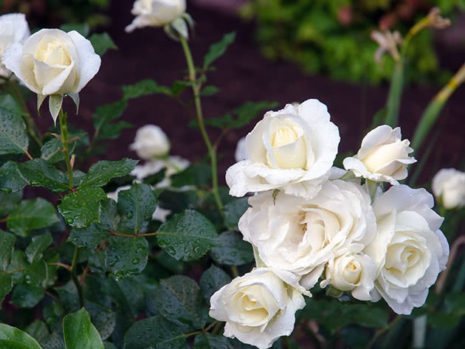

This group includes many varieties and hybrids of plants with different bush habit and flower shape. Such dissimilar plants are united only by the color of the buds - they are always white or cream. White roses are demanding on the quality of the soil, constant feeding. Bushes of different types can grow from 50 to 150 centimeters. Most often they are compact, have strong long erect shoots. Flowers are formed singly, one on each branch. The buds are most often goblet-shaped. Plants bloom almost all summer.
The best varieties:
| Variety name | Characteristic |
| White Christmas | The variety was obtained in the USA in 1953. Bushes are vigorous, but narrow. Shoots are long, strong. Plant height reaches one and a half meters. Leaves are dense, slightly wrinkled. Terry flowers, their diameter is 10-12 centimeters. There are few petals, so the bud opens into a loose flower. One shoot forms from one to three inflorescences. The flowering is lush and abundant, lasting all summer. The petals have a bright aroma. |
| Schneewittchen | One of the most famous varieties with odorless flowers. A rose can be grown in the form of a bush or tied to supports, so it will trudge along a given surface. It has an average resistance to diseases, therefore regular spraying with fungicides is required. |
| Mount Shasta | Created over 50 years ago, this rose is considered one of the most beautiful to this day. Vigorous bushes with good vigor. The height of the bush is within 120 centimeters. Leaves are green matte with a bleached shade. The buds are large, conical, and consist of 25 petals. Their color is pure white. Flowers on the shoots are formed singly, which allows them to be used for cutting. |
| White Roadrunner | The rose was bred in Germany in 2001. Densely leafy bushes are undersized, their height is often barely 50 centimeters. Leaves are dense, leathery, dark green matte color. Blooming buds are in the shape of a bowl. The petals are loose, ordinary, the diameter of the flower is 5-6 centimeters. The buds are collected in 5-8 carpal inflorescences. Long-lasting, undulating flowering. Roses have a wonderful tart aroma. |
| Blanca Parade | A completely new variety from Denmark. It belongs to the dwarf species. The height of the bush is 30-40 centimeters. Shoots grow to the sides, from this the view of the bush is spherical. Flowers are semi-double, up to 4 centimeters in diameter. One shoot produces 1-3 buds. Lush flowering, 2-3 times. |
Red
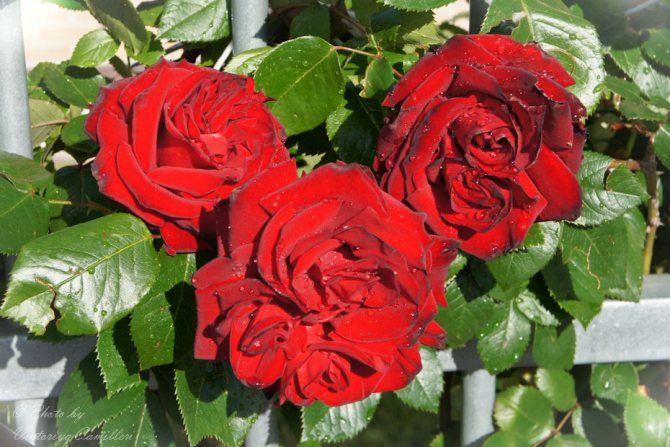

This includes a group of roses introduced from Central Europe. All of them are characterized by vigorous bushes (up to 2 meters high), long purple-carmine-colored shoots with a bluish bloom and almost complete absence of thorns. Red roses bloom usually in the second half of summer for 20-25 days. The petals are red with deviations in shades (from light pink to burgundy). Most of the varieties are very decorative due to the large spherical terry fruits. All red roses are undemanding to care, winter-hardy.
The best varieties:
| Variety name | Characteristic |
| "Piano red" | Bred in 2007. Bushes grow up to 130 centimeters. Shoots are thick, erect. When opened, the bud has a spherical shape, but the fully opened petals fold in a bowl. The number of petals on a flower is up to 60, which makes the bud dense and hardy. Terry flowers, up to 11 centimeters in diameter.Roses are collected in inflorescences of 8 pieces. They smell weak, sophisticated. The variety has an average resistance to infectious diseases. Long bloom, from mid-June to late September. |
| Red Eden | The variety was obtained by the French at the beginning of the 21st century. Bushes are indeterminate, up to 2 meters high. Stems are green, without thorns. The flowers are large with crimson double petals with a silvery sheen around the edges. The buds are collected in inflorescences-baskets of 5 flowers. The aroma is strong with a fruity note. Plants never get sick, they are able to live without additional care. A remontant variety, it blooms twice a season. |
| "Bel Ange" | This rose was created in 1962. Tall bushes reach almost two meters in height. The leaves are light green, shimmer with emerald in the sun. The flowers are bright red, their diameter is 10-12 centimeters. The buds are glass-shaped. They are located singly or 8-10 pieces in inflorescences. Have no aroma. |
| "Black Magic" | One of the most beautiful German roses. Created in 1997. The bushes are medium-sized, one meter high. The shoots are overgrown with glossy dark green foliage. The color of the petals is dark red, closer to burgundy. The buds are elongated, velvety, large, up to 20 centimeters in diameter. Collected in baskets of 3-5 pieces. Roses bloom at the end of May and delight the eye until late autumn. Flowering is consistent, two-fold. |
It is interesting!
In Japan, breeders have developed a variety called the Chameleon. Its flowers are colored red during the day, which turns white with the onset of night.
Pink
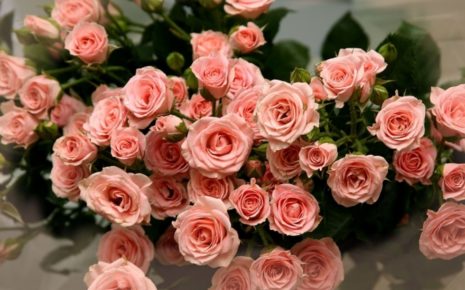

Roses with petals painted in various shades of pink are a symbol of virgin purity, youth, love. That is why pink flowers are deeply loved all over the world. There are many varieties with pink flowers. All of them differ in the height of the bush, the shape of the flowers and the duration of flowering. Usually, pink rose bushes are medium-sized, compact, with long lignified shoots.
The best varieties:
| Variety name | Characteristic |
| "Boscobel" | English variety, bred in 2012. The plant is erect, up to 120 centimeters high. The bush has a fairly compact shape, takes up little space. Stems are green, slightly studded. The flowers are large, densely stuffed with salmon pink petals. The opened buds are in the shape of a deep-cored cup. Up to five flowers are collected in one brush. The variety is characterized by high resistance to diseases. It blooms 2-3 times during the growing season. |
| Miss Piggy | Dutch rose, bred in 2010. The height of the bushes usually does not even reach a meter. The bushes make up long, upright shoots, which are framed by dark green, dense foliage. The flowers are bright pink with a salmon core. They are very large, reaching 8-10 centimeters in size. The aroma is strong, traditionally pink. Each shoot forms one to three buds. Cut flowers are stored for a long time and do not lose their aroma. |
| Paris Charm | In 1965, the Germans bred a rose in the French manner and named it after the great Paris. Paris charm is characterized by small semi-spreading bushes with long, tight shoots up to a meter in height. On the lush green foliage, in contrast, large 10-centimeter thick double roses fall, which gather in huge inflorescences of 3-5 buds. The color is initially pink-orange, gradually turning into pale pink. The variety is loved by summer residents all over the world, thanks to its lush and long flowering. |
| "Osiana" (Oceana / Osiana) | The variety was created 30 years ago. Osiana is a vigorous shrub with branched long flexible shoots that are overgrown with large sparse foliage. Terry flowers 10-12 centimeters in diameter bloom slowly, one after another, throughout the summer. On each shoot, one fragrant rose is formed. Flowering continues throughout the summer months.The variety is successfully used for cutting, as the flowers can retain their spectacular appearance for up to two weeks. |
By the way!
Miss Piggy has been awarded the New Best Variety award.
Orange


Flowers with an extraordinary color of petals began to be cultivated at the beginning of the last century. Most carrot-colored varieties are miniature bushes that bloom profusely all summer. They do not cause trouble for the summer resident, they are unpretentious in growing conditions. Flowers are usually medium-sized, densely doubled.
The best varieties:
| Variety name | Characteristic |
| "Lambada" | This species was obtained in Germany in 1992. The plant is a powerful sprawling bush that grows to human height. Terry flowers, poorly stuffed with petals, open into a cup-shaped shape. The diameter of the buds is 9 centimeters. A distinctive feature of the flowers is the uneven edges of the petals, it seems that they are in a dance. These roses have a pleasant aroma, barely perceptible. Lambada will bloom in late June and bloom until frost. The variety is resistant to many diseases, not afraid of bad weather conditions. |
| "Ty Time" | The variety was obtained in Germany by breeding in 1994. It is one of the most sought-after varieties in Europe. The bush is medium-sized, up to a meter high. Shoots are long, growing upward, forming a compact shrub. The flowers are double, orange with a copper tint. The buds are quite large, up to 10 centimeters wide. TiTime blooms twice a year. |
| "Ninetta" | Dwarf variety. The height of the bushes barely reaches 30 centimeters. The buds are small, with double petals. Dissolve in the form of a cup. On one shoot, up to 8 pieces are formed at once. Roses of Ninetta are great for decorating the borders and foregrounds of the flower garden. |
| "Goldelse" | The variety belongs to the floribunda group. Bright orange flowers are spherical. They are densely dotted with small shrubs, sometimes completely covering the few foliage. Each branch bears up to 8 peach-colored buds, which fade to yellow in the sun. |
Black
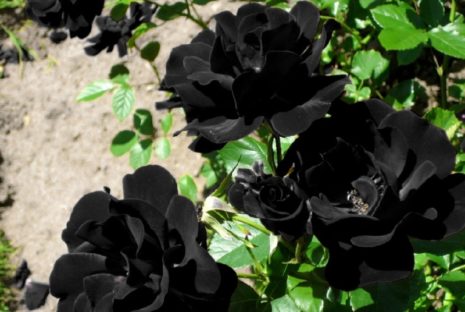

In nature, there are no flowers with black color, although breeders do not give up trying to get such roses by selection. Roses with petals of dark red, burgundy shades are considered black. The edges of the petals in these species can be really black, but the rest of the petals remain maroon.
The best varieties:
| Variety name | Characteristic |
| "Black Prince" | An old English variety, bred at the end of the 19th century. In fact, rose petals have a deep red hue, but their edges are so dark that it seems the rose is painted black. Plants of the Black Prince are tall, reaching one and a half meters in height. Shoots are weakly studded. The flowers are large with 50-55 petals. They are in the form of a socket. The diameter is 8-9 centimeters. The aroma is strong with a wine tinge. The black prince has strong immunity, does not react to temperature extremes. With proper agricultural technology, it blooms twice a season. |
| "Baccarat" | The species was created in 2000 in France. The shape of the bush is erect, spreading. There are few thorns. The flowers are terry, cup-shaped, up to 10 centimeters in diameter. The petals are dense, resistant to rain and wind. Their ends are slightly pointed. The color of the roses is burgundy brown with a silvery tint. Blooms profusely and continuously throughout the summer. |
| "Barkarol" | The most popular variety in Germany. Bred in the same place in 1998. The Barcarole bushes are low, up to 80 centimeters high. The buds are goblet, pointed at the ends, with a clear shape. The flowers are dense and large. A winter-hardy variety that, in conditions of extremely low temperatures, shows all the beauty of the flowers - they become almost black with a glossy moon tint. The stems are long, strong, erect, which makes the variety suitable for cutting.Its only drawback is its susceptibility to powdery mildew. |
| Black Magic (Black Magic) | A variety of hybrid tea roses, obtained by the Germans in 1997. Suitable for cutting and decorating flower arrangements. The buds look almost black in their prime. The center of the flower remains blood red. The lower petals are completely black. Has a strong immunity to diseases, winters well. Flowers are preserved for a long time in cut form (up to 20 days). |
On a note!
Black is considered the color of business style. Therefore, a bouquet of black roses, presented as a present, can play a good service.
Bicolor varieties
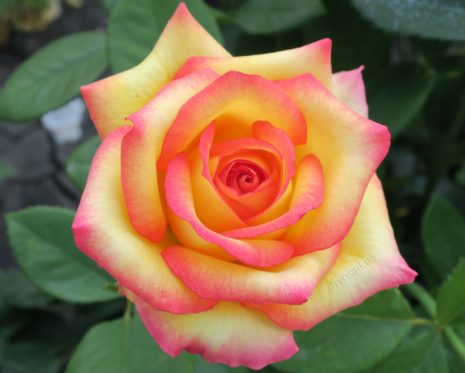

Today, two, three and even four-color roses are no longer a rarity. Breeders skillfully cross a wide variety of varieties to produce roses of the most unexpected colors. You can find burgundy-lemon, pink-white, orange-red varieties. Often such flowers change their color palette during flowering.
The best varieties:
| Variety name | Characteristic |
| Chicago Peace | A low bush is overgrown with dense double inflorescences of various colors of flowers. In fact, it is impossible to predict exactly what the color will be - it all depends on the climate, soil fertility, agricultural technology. Thus, you can get pink-yellow, orange-salmon, pink-salmon and other color combinations. |
| "Variegata di Bologna" | The bush is vigorous, can reach a height of three meters. Strongly bush, hundreds of medium-sized double flowers are formed on numerous shoots. The flower itself is white with pink strokes and stripes. The diameter of the bud when opened is 5 centimeters. The Italian blooms once in the middle of summer. |
| "Abra Climber" | Two-meter bushes during flowering are covered with huge 10-centimeter striped flowers. On the petals there are longitudinal stripes of burgundy and lemon flowers. Abra Climber blooms several times a year. The variety is winter-hardy, it rarely gets sick. |
| First lady | The cup-shaped buds bloom slowly, following each other, gradually forming a voluminous, tasty-smelling cap. The blossoming rose has a whitewashed heart and more juicy pink edges. The rose bushes of the First Lady are quite bushy, so they need to provide a lot of space for proper development and abundant flowering, which lasts two months. |
Fact!
Bicolor roses are so popular because of their versatility. They look spectacular in a single planting, harmonize perfectly in a multi-species flower bed and create a magnificent view while in a vase.
Rosaries


Traditional rose garden plan
We will accentuate the diversity of roses with a simple splash of evergreen perennials. Refined conifers, openwork ferns will skillfully create a background for regal buds. Their price tag is negligible in comparison to such a picturesque winning landscape.
Traditional rose garden
- The front part is covered with ground cover miniature plants, forming a fragrant colorful carpet.
- We will populate the middle line with bushes of a colorful floribunda palette or hybrid tea with a height of 90 - 130 cm.
- Tall climbing pink trees are solo plants: they should also stand out with the brightness of the petals. For stability, 10 cm from the trunk on the windy side, dig in a stake and tie high pink lashes to it.
- The elastic attachment for the garter of plants will simplify the care of the crown.
Note! Electrically heated conservatory rose gardens are great even in cold weather, and renting a diesel generator for a summer residence is profitable because it is not expensive.
- The curtains of the rose garden are formed by a curling rose, which on the supports will reach 5 meters. A variety of this beauty is climbing, and she herself is well kept on a support.
Hedge
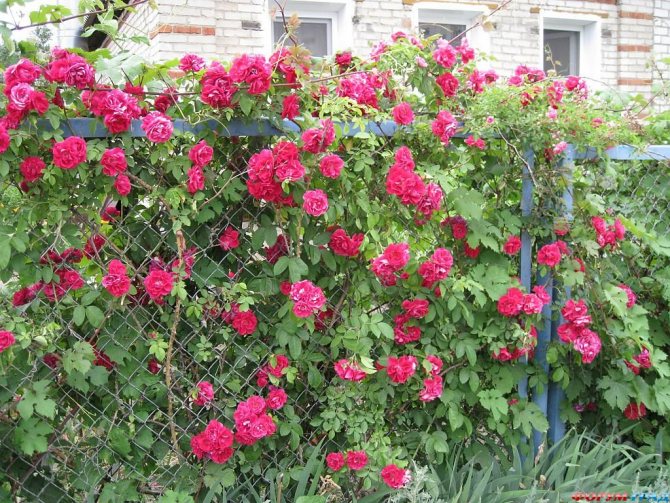

There is no more beautiful hedge of climbing roses.
- Rose bushes picturesquely frame the site or its individual zones: a cozy utility yard from a lovely island for relaxation.One-row "border" in the garden will be laid by meter-long bushes, the distance between which is up to half a meter.
- With a multi-row two- or three-tiered fence, we will plant low plants in front and further in a checkerboard pattern, but strictly in growth to the last one and a half meter giants.
- For a hedge at a summer cottage, 2-year-old bushes are good.
Advice! The last row should not be closer than half a meter to the main fence or wall, so that free ventilation of the plants is preserved, suppressing mold and mildew.
Description
Tea roses (Tea) belong to the old class of roses. They are re-flowering climbing shrubs with smooth shoots or sparsely large red thorns.
Tea roses:
- Leaves - shiny dark green or light, medium size, lanceolate (oblong with a pointed tip);
- Flowers - smell of various spices, semi- or densely double-shaped, arranged singly or in bunches of three, bloom on annual or biennial shoots;
- Coloring - usually pastel shades: white, yellow, pink, apricot colors.
They are characterized by a pointed bud, which opens in a spiral, and the edges of the petals curl outward. This shape has become a classic in modern roses. Used in protected areas as species and for border decoration.
Wintering
It is very difficult for a tea rose to survive the winter in central Russia. She is thermophilic. If there is insufficient cover, it will die.
- Before wintering, cut off all diseased shoots. They collect them and fallen leaves, and then burn them.
- The bush is mulched high with compost or peat, this will prevent the roots from freezing.
- The whips of the curly tea rose are removed from the support. Roll up in a ring. Lay on spruce branches.
- A frame is erected above them, burlap is placed on top, and a film on it is fixed with improvised materials.
- The ends of the shelter are left open for air circulation. Close when a stable subzero temperature is established.
Beneficial features
The wonderful and amazing tea rose varieties have been popular for centuries. However, it is not only the scent of the gorgeous flowers and their beauty that gives everyone respect for this variety. They began to brew flower petals a long time ago. In the beginning, this was done because of the amazing aroma of the drink.
The tea brewed from the petals also has a refreshing and healing effect. With the development of science, the medicinal properties of the noble flower began to attract scientists and representatives of alternative medicine.
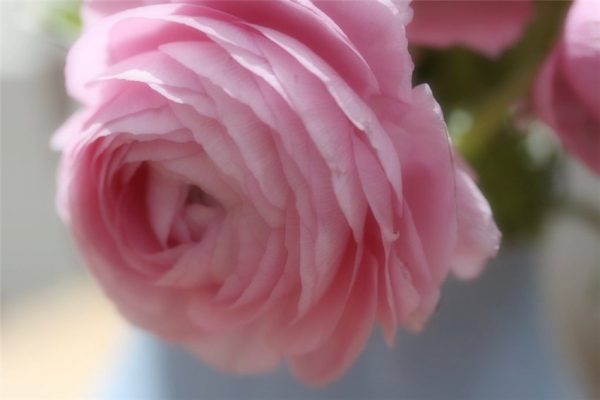

Noble tea rose flower
Tea rose is a real treasure trove of vitamins, nutrients, oils and minerals. Its medicinal properties are as follows ׃
- normalizes the digestive tract;
- increases the body's resistance to viral and colds;
- strengthens the immune system;
- cleanses the body of toxins and harmful substances;
- helps with angina;
- normalizes the microclimate in the intestine;
- stabilizes the endocrine system;
- helps with diseases in the oral cavity, in particular with stomatitis;
- helps to improve kidney function, excretion of excess fluid;
- regulates stool;
- stabilizes the liver;
- relieves irritation and apathy, improves mood;
- helps to get rid of depressive conditions;
- normalizes night sleep.
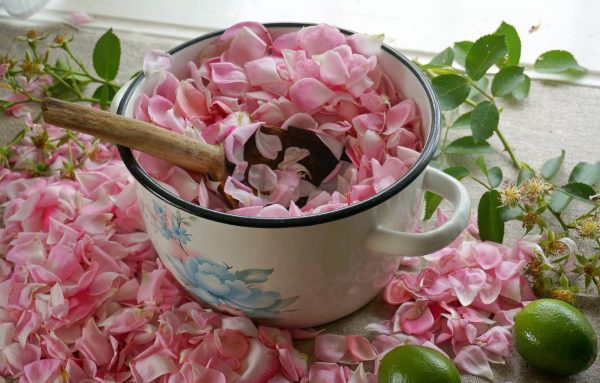

Tea rose is good for your health
With such a large list of useful properties, the tea rose is rightfully considered not only a noble decoration at home, but also a home doctor.
The petals and leaves of the plant are used not only for medicinal purposes. They are a very valuable raw material in the production of cosmetics and anti-aging skin and body care products. After their application, the skin is moisturized, becomes velvety and smooth.
Tea rose essential oils are widely used in perfume production.Rose water has more than just a rejuvenating effect, being a part of many tonic lotions and tonics. It is used in eastern countries to prepare famous national sweets that have an amazing taste and smell.
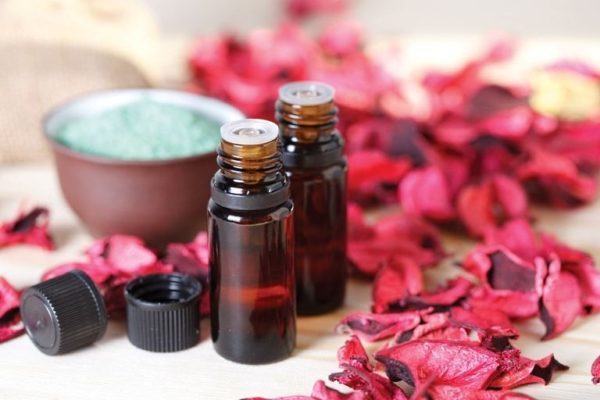

Tea rose essential oil
Photo
In the photo below you can see how beautiful indoor bush tea roses look like.
Watering
Before rooting, the planted rose is watered daily. Then the number of waterings is reduced. The tea rose is susceptible to fungal diseases; it does not need waterlogging. Therefore, adult bushes are watered no more than once a week, but with plenty of water (at least a bucket). Water is poured at the root, trying not to get on the leaves and flowers. Delicate tea rose petals do not like water droplets falling on them, as they lose their shape and color.
With a lack of water, the buds become smaller, and the smell weakens. Therefore, in dry summers, the frequency of watering is increased.
History
Tea or scented roses first came to Europe from Asia in the late 18th and early 19th centuries. Presumably from China. Their distinctive feature was an extraordinary aroma that resembled the smell of tea. Perhaps this scent explains their name.
There are other versions as well. Some argue that their shape made them call roses tea. The blossoming flower looks like a bowl from which the Chinese drink tea. Others believe that the "tea house" corresponds to the name of the country "China" (China). Still others say that the seedlings arrived on clippers (high-speed sailboats), which brought tea to Europe.
A native of southern latitudes, it was difficult to take root in a more severe climate. She didn't like the changing seasons: short summers, cold autumn and spring, low winter temperatures. Breeders have gone to great lengths to accustom them to temperate climates. They succeeded. But tea roses are still very afraid of frost, they must be well covered for the winter or grown in greenhouses and greenhouses. Therefore, they feel comfortable only in the southern regions of our country.
Photo gallery
Cooking applications
Folk recipes include making scented tea. Flower petals are used to make amazing jams with a very delicate taste and delicious aroma. Decoctions are made from stems and leaves, medicinal tinctures are prepared.
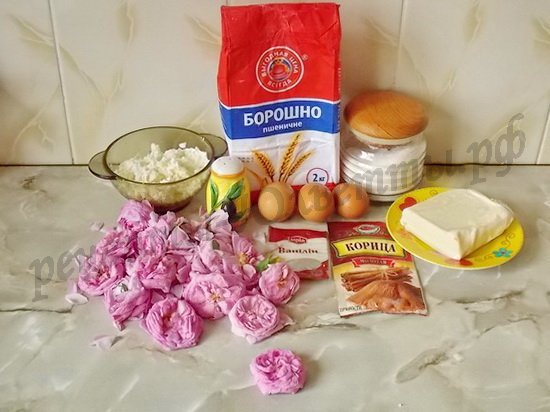

Tea rose in cooking
Tea is brewed from the finest velvet petals. It turns out not only tasty, but also beautiful. Petals are often mixed with ordinary tea to give it a special flavor and unique smell. When the Chinese rose is brewed correctly, the drink will have a subtle honey flavor.
The tea rose is one of the most expensive varieties of these beautiful flowers. Only this variety is used to prepare the world famous amazing drink.
Basic rules of care
To make it easier to navigate what conditions are needed for the normal development of capricious flowers, you need to remember certain rules:
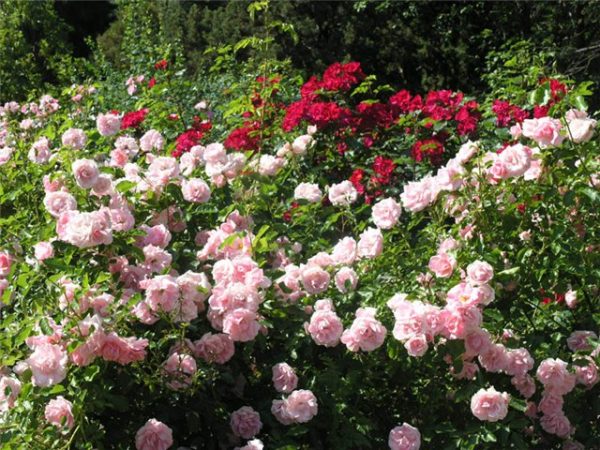

Tea rose in a flower garden
- The plant is planted only in the soil that is intended for this variety.
- A proud beauty can stop blooming and even begin to fade when the ambient air is unstable. If they plan to put it on the street, before that they must be hardened. How is it done? With the onset of the first spring days, the windows are opened indoors for several hours. This method of airing will significantly "strengthen" the flower and provide abundant flowering in summer.
- If the queen of flowers begins to get rid of leaves and flowers, she gets too much sun on this windowsill, she is hot.
- The comfortable temperature for the full development of the plant in summer is 25˚C. The rose should not be taken out to a place where it will be under the scorching rays of the sun. In this case, she is left in her usual room.
- In winter, it is vitally important for the plant to receive the "prescribed" portion of light. It is enough to turn on the lighting after dark and turn it off at night.
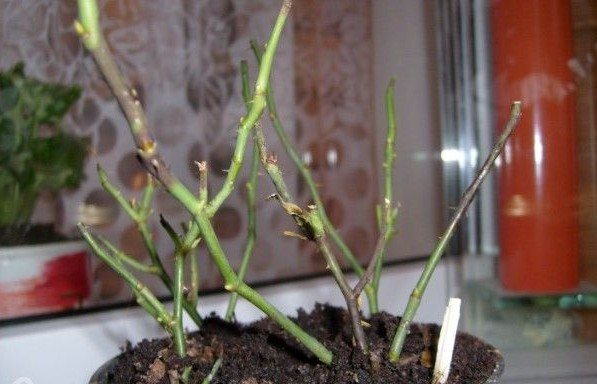

Tea rose cuttings
For more information on mineral and organic additives, you can find out on thematic forums, or by watching videos of experienced florists.
Video - Top dressing of a tea rose
It is best to buy ready-made fertilizers in flower shops, which are accompanied by a recommendation for breeding the drug.
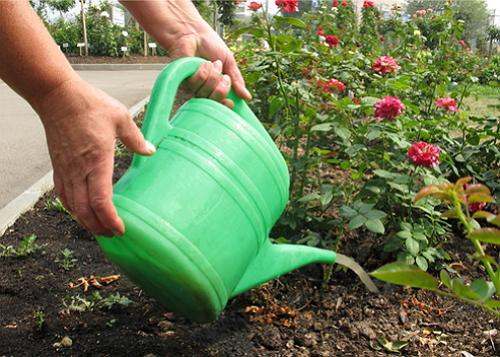

Fertilizing roses

